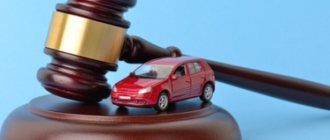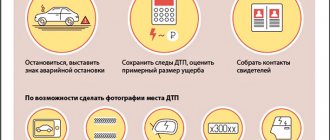Transferring the vehicle to a service station
I propose to start the conversation with how to hand over a car to auto mechanics. So, the claim about the occurrence of an insured event was considered, the damage was assessed, and the insurance company issued the driver a referral to a service station. Let me remind you that restoration work is carried out at technical stations that have relevant agreements with the UK. The car owner has the right in advance, when purchasing a “citizen car”, to choose from the proposed list the service to which his vehicle will be sent in the event of an accident.
Chapter 6 of the Regulations of the Bank of Russia dated September 19, 2014 “On the rules of compulsory insurance of civil liability of vehicle owners” No. 431-P is devoted to the conditions for carrying out the work.
This is what is stated in the document:
- The service station must be located no more than an hour 50 km from the scene of the accident or the residence of the car owner (except for cases when the insurer undertakes transportation of the vehicle there and back);
- Cars under 2 years old must be repaired at service stations of official dealers.
Accordingly, if you did not take care of choosing a car repair shop in advance and you were given a referral in violation of the above requirements, you can refuse such services. Well, if everything is in order, then you can safely take the car to the service center.
So, the car arrived at the service station. What happens next? And then an act of acceptance and transfer of the car is drawn up. It should contain the following information:
- detailed information about the car;
- list and description of car damage received in an accident;
- date and purpose of contacting the service station;
- information about the workshop that accepts the car.
The document is signed by both parties and sealed with the seal of the technical station.
Poor quality repairs, repairs are overdue?!
We will check the quality of the repair for free!
will help you resolve financial issues with insurance and car service, and check the legality of car repair deadlines.
A professional auto lawyer
will draw up a claim to the organizations that violated the law without any advance payment, and, if necessary, prepare a statement of claim to the court.
Our services:
- Inspection of the car before delivery and acceptance for repairs (inspection report)
- Pre-trial and judicial settlement for poor-quality repairs
- Recovery of damage from an individual
- Providing services for receiving funds instead of sending them to a service station
- Part repair failure
The consequences of most road accidents must be eliminated. But what to do if the insurance repair deadlines were ignored or the car has still not been repaired?
It is not uncommon for a car to take weeks to be repaired at the direction of an insurance company. Instead of making the necessary repairs on time, service and insurance often delay the restoration of the car without any explanation. Sometimes it happens that the insurance company refuses to issue a referral to a service station to repair a damaged car or does its best to delay the process of issuing the paper.
What to do if the insurance company's repair period does not comply with the law? What to do if the cost of car repairs has increased significantly due to the fact that the insurance company has delayed the repair period?
Due to the fall of the ruble, purchase prices for spare parts have increased significantly, which has affected the cost of car repairs, especially those made abroad. Exchange rates continue to rise, and purchases of spare parts are made in foreign currency.
Many motorists, through no fault of their own, find themselves in a situation where an insurance company issues a referral for car repairs with a ready-made estimate, and service station employees are ready to repair only half of the damaged parts for the money provided. Due to inconsistency between the insurance company and the service station, motorists are forced to pay the difference in the cost of repairs out of their own pockets, fearing that partner organizations will delay repairing the vehicle for weeks or even months while they agree on the final cost of the repair.
Why should a motorist who has already suffered in an accident suffer because of poor interaction between service stations and insurance companies? Why should he waste his nerves, undermine his own health, seeking compensation commensurate with his expenses?
will help you - We work without prepayment!
Prices and conditions
Scroll the slider to find out what percentage of the reward we are entitled to. If the amount of damage exceeds 350,000 rubles, the percentage of remuneration is calculated individually.
Calculated individually
Reward
from to P
Poor quality repairs: a general concept
What does the law and the Unified Methodology say about poor-quality repairs? The presence of deficiencies is indicated by:
- The gaps between the parts are different or different from those that were before the accident. They must be verified by the auto mechanic who carried out the work.
- Paint that is unevenly applied, varies in color, or comes off easily. Such signs indicate low quality of car painting.
- Extraneous sounds when the machine is operating, reduced traction or other technical problems.
- The presence of chips, irregularities and unpainted elements on parts that were subject to restoration.
- During the repairs, used spare parts were used (which contradicts clause 15.1, article 12 of the Federal Law “On Compulsory Motor Liability Insurance”.
In accordance with the Determination of the Armed Forces of the Russian Federation dated March 27, 2017 No. 4-KG17-4, as a result of restoration repairs, the car must be brought to the condition in which it was before the traffic accident. The same is stated in paragraph 18, article 12 of the Federal Law “On Compulsory Motor Liability Insurance”.
Claim: form, content and attached documents
We move on to the next stage - preparing a claim. Disputes with insurers are not a simple and lengthy process, so I recommend involving a specialized lawyer in the case at this stage. But, if for some reason you decide to fight for your rights on your own, then remember what statements the appeal to the Investigative Committee should contain:
- full name and details of the insurance company;
- personal data of the policyholder (full name, address, contact telephone number);
- description of the problem;
- the essence of the requirements;
- links to legislative acts whose norms, in your opinion, have been violated;
- bank account details (the car owner can refuse repeated repairs and demand a cash payment);
- list of attached documents;
- signature and date.
Next, we collect a package of documents. You will need copies:
- civil passport of the car owner;
- MTPL policy;
- documents for the car (PTS, STS);
- directions for car repairs;
- results of an independent examination (if any);
- certificate of acceptance and transfer of the vehicle after completion of repairs with the specified defects.
If the claim is prepared and submitted by a representative, then he signs the document and confirms his authority with a notarized power of attorney, a copy of which is also attached.
You can submit a request in two ways:
- hand over in person (through a lawyer);
- send by mail.
In the first case, the document is submitted in 2 copies. On what remains with the owner of the car, the insurer puts a mark on acceptance and registration of the claim. The date indicated in the stamp is the “reference point” of the time allotted for its consideration.
When choosing the second method, do not forget to send the papers by registered mail with a list of attachments and notification. The date entered in the latter will be considered the beginning of the expiration of the period for consideration of claims.
What to do in case of poor-quality repairs under OSAGO
Regardless of whether poor-quality repairs under MTPL are discovered during the acceptance of the car or after it, the action plan will look approximately the same:
- Conducting an independent examination that will establish the fact of poor-quality repairs.
- Drawing up a claim, which will then be sent to the insurance company.
- Direction of the claim.
- If the insurer refuses to fulfill its obligations or does not respond for more than a month, the next step will be to go to court or one of the organizations that regulate the actions of insurers (RSA or the Central Bank).
The claim to the insurer is written in free form, but it must contain the following data:
- the name of the organization against which the claims are made;
- Full name or name (for legal entities) of the victim;
- addresses of the parties;
- description of the incident after which repairs were needed;
- the requirements and their justification;
- a message about what the claimant will do if the requirements are not met (for example, going to court);
- bank details (if the requirements involve the payment of money);
- date and signature.
A claim can be submitted to the insurer in one of two ways:
- Personally into the hands of a representative of the insurer. In this case, the document must be drawn up in two copies, one of which is transferred to the insurer. The second remains with the applicant. In this case, it must be marked with acceptance.
- Send by registered mail, with an inventory and acknowledgment of delivery. In the inventory, indicate a complete list of attached documents.
In the first case, the response period will be counted from the date indicated on the document. In the second - from the moment of receipt of the notification.
The claim must be submitted to the insurer, and not to the company that carried out the repairs. Copies of the following documents must be attached to the claim:
- passport of the victim;
- confirmation of car ownership;
- insurance policy;
- accident documents;
- repair contract;
- act of acceptance and transfer of the car;
- expert opinion that the repair was carried out poorly.
If defects are discovered before acceptance of the machine
When accepting the work of the service center masters, the car must be carefully inspected. All detected defects must be included in the acceptance certificate, and only then can it be signed. Here you need to remember that the insurer can put pressure on the fact that the work acceptance certificate has legal force. If it is signed without comments, this means the client agrees with the quality of the work performed. And also that he has no claims against the contractor, and, therefore, against the insurance company.
In this case, it will be very difficult to obtain a court decision in favor of the owner of the car. An expert's assessment, if carried out directly upon receipt of the car, can only worsen the situation. Since this can be interpreted as saying that the client was aware of the remaining defects, but agreed to accept his vehicle in exactly this form.
It would be a good idea to work with an independent expert who can determine on the spot how well the repair was done. But you can conduct your own examination after receiving the car.
In case of serious deficiencies, it is better not to sign the transfer and acceptance certificate and call a representative of the insurer on the spot. After the inspection, the technical center may agree to fix the problems found on its own. Otherwise, you need to file a claim with the insurer. And if this doesn’t work, contact the regulatory authorities.
Defects were identified after signing the acceptance certificate
Some defects cannot be detected upon receipt of the vehicle. They are detected already during the use of the machine. Such problems include too rapid overheating of the engine, the appearance of suspicious noises, greater consumption of fuel and other liquids, and similar deterioration in the operation of the car.
In this case, the examination should not be carried out to detect defects, but about how safe it is to use this vehicle and how well it works.
Further actions will be exactly the same as if the defects were discovered during acceptance of the work. However, the trial may take longer because more additional information may be needed to make a decision. In particular, if after repair the vehicle has traveled more than 150 km, or if spare parts that have already been repaired under compulsory motor liability insurance have been independently replaced.
Further actions
If the insurance company decides to review the claim, they will set a date for the vehicle to be re-inspected. During the procedure, the owner, a representative of the insurer and the car service center that performed the repair are usually present. The assessment is carried out within 5 days after receiving the requirements.
The claim itself is considered no more than 10 working days from the date of its receipt. The answer to the requirements could be:
- issuing a referral for repeated repairs;
- payment of funds;
- refusal to satisfy demands.
Replacing repairs with payment of compensation is possible if such an agreement is reached between the applicant and the insurance company or if the repair work cannot be repeated.
Who should you file a complaint against if you have done poor quality repairs under CASCO?
If a service station, at the direction of the insurance company, performed poor-quality repairs on the vehicle, you have the right to demand that these defects be corrected from the service center or from the insurance company. At the same time, it is necessary to understand that all legal relations you have arise only with the insurance company, since you, as the policyholder, are bound to the insurance company by the CASCO insurance policy, which provides for your rights and obligations of the insurance company arising in the event of an accident.
For an insurance company, the implementation of insurance compensation in the form of repairs and the payment of funds are equally reflected on the financial side.
To receive insurance payment under CASCO for poor-quality repairs of a vehicle, you must:
- conduct an independent examination to determine the cost of repairs
- file a claim in writing with the insurance company
- hand over the claim and a copy of the examination against signature from an employee of the insurance company
- in the absence of insurance payment, file a claim in court
After this, you can repair the vehicle yourself or with the involvement of third parties.
Received a refusal: what to do?
If the insurance company refuses to satisfy the demands, the car owner can try to file a complaint with the Russian Union of Auto Insurers or the Central Bank of Russia. These bodies monitor the activities of insurers in matters related to the “motor citizen” and are able to influence them. Complaints are reviewed completely free of charge, so I always recommend using this opportunity.
The second option to solve the problem is to go to court. To do this, you need to prepare and submit a statement of claim, as well as collect evidence. If the car owner did not order an independent examination before filing a claim, then it must be carried out before filing a claim. It is the results of the study that will serve as proof that the quality of repairs “leaves much to be desired.” If you have not used the services of a car lawyer up to this point, then at this stage I recommend engaging one. As practice shows, unscrupulous insurers who want to save on repairs and do not admit shortcomings always go to the end and seriously prepare for litigation, so it will be difficult to do without a lawyer.











